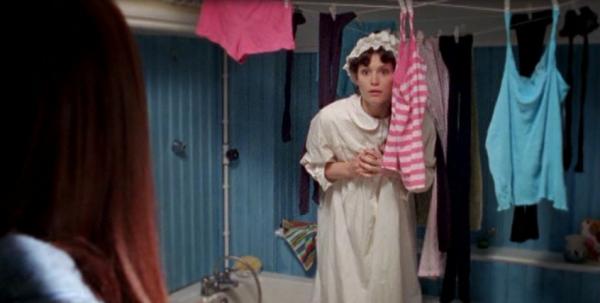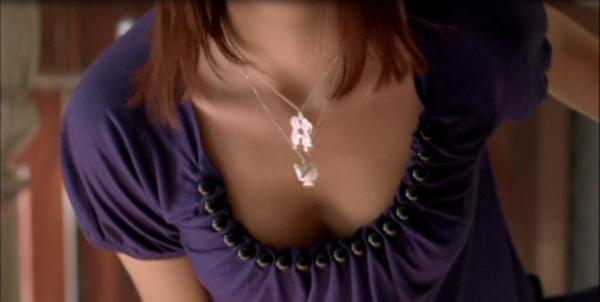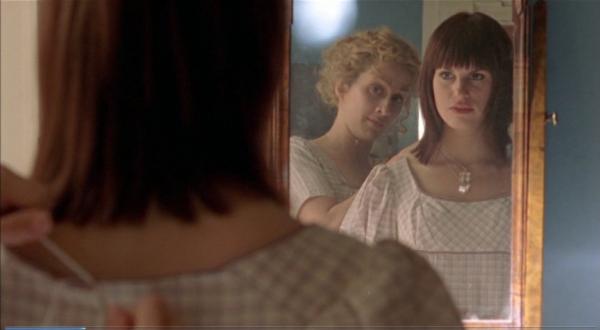DAN ZEFF’S LOST IN AUSTEN (2008) IS AN ADAPTATION about adaptation. It examines the culture of the modern Jane Austen fan base and the way in which we read, perceive, and adapt Austen novels. The four-episode miniseries follows Amanda Price, an original character, into the world of Pride and Prejudice as she escapes a life in twenty-first-century London that is falling short of her standards. By making reference to other Austen novels and adaptations, Lost in Austen creates an intertextual world that reflects the landscape of contemporary Austen fandom. The series is self-conscious of its status as adaptation and irreverently takes liberties with Austen’s characters. In a wonderfully metafictive moment, for instance, Amanda notes that Austen must be spinning in her grave, “like a cat in a tumble dryer” (Lost in Austen, Episode 4). There are casualties of the plot: Jane is briefly married to Mr. Collins, Lizzie stays in twenty-first-century London, and Charlotte Lucas escapes to Africa for life as a missionary. Other figures surprise us by their “true” character: Miss Bingley is a Sapphist, Wickham a sly hero, and Mrs. Bennet more aggressive than silly. We are called to wonder if Amanda really is—as she claims to Bingley after she drunkenly snogs him in Episode 1—an infection. Amanda, lost both figuratively and literally in Austen, represents the modern reader’s interaction with Austen’s works. As Amanda moves through the text, acting and reacting, she is the quintessential modern Austen fan, both reader and adapter.
The fans of Jane Austen have been called Janeites, in reference to Rudyard Kipling’s short story about soldiers reading Austen in the trenches of World War I. It is appropriate that take their name from her Christian name: the fan culture of Jane Austen is based in a sense of exclusivity and personal intimacy between the reader and Jane herself. As Claudia Johnson writes, “A review of literary commentary suggests that Austen’s devotees are particularly inclined to see her ghost” (5). This statement is a succinct expression of the relationship Austen’s fans feel with “Jane,” as though merely by reading and loving her novels, they may be deserving of a posthumous visit; the fan admires Austen and is as indebted to her as she is privileged to know her. While Johnson seems to mean “ghost” literally, it is a fitting word to describe Austen’s permeation of our cultural and popular cultural history, as though she has haunted us, and to describe the indistinct way in which we are destined to know her, due to the sparse record of her biographical history. Austen is simultaneously a sacred object of devotion and a precious possession. In the same vein, fans and readers feel a curious but particular claim to her body: Johnson writes, “I overheard a Janeite from Bath bragging about acquisitions to the Jane Austen study centre there, but her enthusiasm was crushed when a Janeite from Winchester rejoined, ‘But we have her bones’” (17). However blessed Jane might be, “Jane Austen” is still a cultural commodity and absent enough that fans are able to vie for any authority they can claim in her place, even with regard to her physical remains.
The desire to possess “Jane” necessarily extends to her novels. It is outrageous to suggest that one might do Austen better than Austen, yet the various adaptations of her novels have begun to include what Alice Ridout calls “appropriation” (15)—which is also the term she uses to describe Lost in Austen—as we see in such iterations as Pride and Prejudice and Zombies (2009). Collectively, Austen’s readers, the robust Janeites, define and redefine her stories through adaptation, by reading, re-reading, and writing.
The idea of adaptation as appropriation brings up, naturally, questions of authorship and fidelity, which I will discuss in terms of Lost in Austen’s mode of adaptation. Claudia Johnson suggests that Jane Austen, the person, remains unknown to her devotees. She discusses Austen’s absence from public fame as both protecting her from certain derision and criticism and allowing others to create an image of her (21). In the absence of a biographical record, Austen’s readers and adaptors frequently read her into her characters: is Austen the polite and demure Fanny Price or the witty, wind-swept Elizabeth Bennet? The intimate voice of Austen’s narrator might lead us to believe that we will find Austen in her text. In Lost in Austen, Amanda’s body stands in for not only Elizabeth’s but also Austen’s absent one. As Alice Ridout notes, “Amanda effectively puts words into Jane Austen’s mouth when she comments to the audience, ‘Goodness, Jane Austen would be fairly surprised to find she’d written that!’”—a statement Ridout cites as an example of the series’ “‘ventriloquism’ of Austen” (17). Perhaps the Janeite is able to escape into the genteel world of Pride and Prejudice only because there is no bodily authoress associated with it.1 In Lost in Austen, Amanda becomes the bawdy author, and suddenly the text and its enchantment are changed.
The body, in its fleshy and corporeal reality, is significantly more present in Lost in Austen than in Pride and Prejudice. I suggest that perhaps Amanda’s mere presence changes the way the story happens; in the same way, our perspective as modern readers is very different from that of Austen’s earliest readers and so alters our experience of the text. We interpret and adapt the text, and our presence (and intertextual engagement with it) changes it. The modern reader (especially the Janeite) possesses knowledge of worlds that are outside the scope of Austen’s novel but are now included in Austen’s textual canon nonetheless. As she reads, Amanda fills in Austen’s spaces—Darcy is Colin Firth; Bridget Jones’s clumsy Elizabeth bridges the gap between Amanda and the heroine—and so creates a new text, even before she finds her way into the novel. Lost in Austen is aware of itself as a reading of Pride and Prejudice. Many of these bawdy “body” moments remind us of both the miniseries’ distance from the original story and the way in which, for Amanda, the “Pride and Prejudice” into which she enters is real. The series is thus intentionally metafictive, and, in the way it disrupts the course of events of Pride and Prejudice, it comments on our own biases as readers and the ways that we, as Jane Austen fans, disrupt the text simply by loving it.
The show comments on our disruption of Austen’s text in its imposition of our modern freedom with the body onto the less physically-oriented world of Austen’s text. When Amanda walks through the portal in her apartment, she forces the characters who inhabit the text into flesh and thus makes them warm and dynamic, mutable from Austen’s novel. Amanda, with her modern tendencies to do things that shock, awakens the potential in Pride and Prejudice for things to have happened differently. She recognizes the influence of her presence and regrets it, telling Bingley, “I feel like those guys who discovered that Stone Age tribe, then gave them the common cold and wiped them out” (Episode 1). Amanda thus sees herself as infecting Austen’s novel, and we have to acknowledge that, if she does introduce infection, it is due to the strangeness she presents. Her inadvertent seduction of Bingley stems from her lack of appropriate clothing, and, just as the contemporary reader comes to Austen with both foreknowledge and anachronisms, her “oracular tendencies” alter the text. However, if Amanda is an infection, she is at least equally an agent of revelation.
The potentialities inherent in Austen’s novel are that Bingley might be drunk, Darcy heartless, Lydia merely bored, and Charlotte Lucas manifestly lonely. The unravelling of the plot thus stems from Amanda’s presence, which functions to encapsulate the vulgarity and boldness of the twenty-first century: Amanda is an ungentle woman in the midst of gentle people. We get a hint of how exactly Amanda will be characterized when Elizabeth, first arriving in her bathroom, addresses her as “Miss Spencer,” having gleaned her name from the labels in the underwear hanging to dry: Amanda is given the name of her unmentionables (which are mentioned), literally airing laundry.

From Lost in Austen.
To span the gulf that separates Amanda from Austen’s world and thus participate in its happy ending, Amanda reads her own body into the novel with a liberating effect: we learn about Miss Bingley’s preference for women because she feels free enough around Amanda to proposition her; in Amanda’s liberating presence, Georgiana Darcy can admit to her failed seduction of Wickham. The switch between Amanda and Elizabeth in Amanda’s London bathroom allows us to see the characters of Austen’s novel in a situation outside of the novel’s plot and symbolically indicates the consequences of the interaction of Austen’s world with Amanda’s. Furthermore, as Amanda’s literal disruption of Pride and Prejudice allegorizes the disruptive work of the modern reader, Lost in Austen allows us to see the consequences of the Janeite on Austen.
Amanda’s body also alienates her from Austen’s world. When she asks for something with which to brush her teeth, Jane points out the birch twigs, powdered salt, and chalk that she has already laid out. (This joke is repeated when Amanda returns to twenty-first-century Hammersmith to find Elizabeth Bennet has a nannying job and “cleans the kids’ teeth with chalk” [Episode 4].) Although comic, this moment also affirms Amanda’s anachronistic status and shows that the other characters notice it. Mrs. Bennet remarks on Amanda’s clothing: “It is a pity that Miss Price’s portmanteau has failed to appear. We must endeavour to furnish her with clothes that are a little less provoking of attention” (Episode 1). The fact that Amanda is more naked than the rest of the women is a more serious error than the chalk.

From Lost in Austen.
When she finds herself in the novel, Amanda assumes she is on a period reality show and that Lydia has been put into bed with her for some “girl on girl action”; she exposes herself to Lydia and must explain that she has groomed her pubic hair. Most would consider this conversation un-Austenian.2 We are surprised to hear Lydia ask, “What have you done to yourself?” (Episode 1). Lydia, who often “get[s] into bed with Lizzie at night” and who (we know) runs off with Wickham somewhat thoughtlessly, might still seem relatively sexless when compared with Amanda, who lived with Michael for a year. Amanda’s body has the power to reveal what is hidden and expose conversations Austen did not record. Amanda, however, does not belong in the text and cannot fully pretend to, and for the first two episodes she moves about dressed in Elizabeth’s clothes.
As she moves throughout the text, however, she liberates characters from Austen’s plot. Ultimately, Amanda’s twenty-first-century body simultaneously others her and gives her power.

From Lost in Austen.
Lost in Austen is self-aware as a postmodern work and as an adaptation, written to be most be appreciated by the Janeite (Kaplan 243). Amanda is the every-fan of Austen, although she insists to her mother, “I’m not hung up on Mr. Darcy. I do not sit at home with the pause button and Colin Firth in clingy pants” (Episode 1).3 Amanda, however, cannot deny her own immersion in Austen adaptations: in Episode 3 she asks Darcy, “Will you do something for me?” We then see Darcy in the garden pond, in a slightly more sexualized version of the “lake scene” or “wet shirt scene” that was famously added to the 1995 adaptation of Pride and Prejudice.

From Lost in Austen.
Amanda calls this scene “a strange postmodern moment.” It is, indeed, one of the moments upon which the series hinges. By bringing a turn-of-the-century pop-culture reference into what the viewer must assume is the authentic world of Pride and Prejudice, Lost in Austen exhibits the fluidity of text, authorship, and adaptation. Amanda here takes charge in an active role. Rather than passively accepting Austen’s text by trying to “corral Austen’s characters” (Kaplan 243), Amanda tells Darcy what to do, canonizing an extra-Austen scene and christening it as her own (indeed, Darcy has just named her: “Amanda. It means she who must be loved.”).
Lost in Austen recognizes that we now read Austen intertextually. Amanda compares Darcy to Colin Firth, who, she notes, “isn’t even Colin Firth. They had to change the shape of his head with make-up” (Episode 1), a comment on our reliance on our own adaptations and interpretations of Austen (which we again might attribute partially to Austen’s authoritative absence). The series also references the 1995 production of Pride and Prejudice in the way the characters are costumed and depicted: when Amanda enters the text, she might as well have entered the BBC miniseries. In the absence of physical descriptions in Austen’s novels, Lost in Austen takes its cue from what may be the most authoritative modern adaptation of the novel. As Amanda demonstrates, Colin Firth is more “Darcy” to us than Darcy (he even appears as Darcy in Bridget Jones’s Diary [2001]). The Darcy of Lost in Austen is decidedly hostile when he tells Amanda, “You repel me. You are an abomination” (Episode 2). Thus, for the modern Austen reader, as for Amanda, the “cult” of Jane Austen (as both Claudia Johnson and Devoney Looser refer to it) extends far beyond her original novels. Amanda, as the reader, is able to pick authoritative versions and read intertextually, to shape the text into something not precisely Austenian (but perhaps Janeite-ian).
If the bathroom is the locus of Amanda’s entrance into the text, then the pond at Pemberley is the locus of her active disruption of Austen. Amanda asserts the authority of the 1995 adaptation when she asks Darcy to step into the pond; when she pursues him as a love interest and then botches it, she oversteps her prior role as a reader by deciding she must step in for Elizabeth. Ultimately, the events around the pond are visually manifested in the heart-wrenching image of Austen’s novel torn apart: upset, Amanda rips the novel to shreds and tosses it into the same pond. As Amanda steps out of her role as reader, she steps into her role as author, a move acknowledged explicitly when Darcy finds the pages of the novel. He believes Amanda has written it and confronts her: “No wonder nothing about you seems plausible. Is your name Price, or is it Austen” (Episode 3)? Darcy’s mistake equates Amanda and Austen and marks Amanda as the new author of the text. As a Jane Austen fan, Amanda adapts the novel with her anachronistic reading (disrupts the text with her body) and actively changes the text with her desire for the same type of love story as Elizabeth and Darcy’s. This desire stems equally from her discontent with her situation and from her love, as a reader, of Pride and Prejudice. Amanda becomes the author because she has been the reader. The post-feminist reader of Austen occupies the unique space in time that allows her to read Austen intertextually and to re-write her.
Amanda occupies the roles of the reader, character, and author of Austen throughout the series. In Episode 1, the audience hears her read snatches of Pride and Prejudice in a voiceover. At the end of the series, she replaces Elizabeth as Darcy’s love interest, thus becoming a character in the novel. She exercises her own agency, however, in doing so and, to the extent that she actively changes it, becomes also the author of the text. The way the transition from reader to author and character occurs in the series is an allegory of reading. Perhaps every reader who loves a book might envision it so vividly, as though he or she is a character within the story; the logical next step, as Emily Auerbach acknowledges, is the reader’s continuation of the author’s fiction—what we know as fan-fiction. Auerbach writes, “The global proliferation of Pride and Prejudice spin-offs, mash-ups and knock-offs, though alarming and overwhelming, proves the power of Jane Austen’s sparkling novel to capture the imagination of its readers, again and again” (197). Lost in Austen specifically looks at the way fans of Jane Austen read and thus write her work. Elizabeth, too, is “trying to write a book” (Episode 1), when she is carving out a life for herself in twenty-first-century London. When Elizabeth exits the world of the text, she easily gains the power of articulating and shaping her own fate that she would have had to fight for in the novel, and she also rewrites Austen’s ending for herself. Indeed, Amanda is the ultimate engaged reader, reading so vividly that she enters the text bodily. Alice Ridout suggests that she is only able to enter the text at all because of her devotion to the novel: “the new heroine . . . is only able to go back and enter the story because of her own love, respect, and repeated reading of Pride and Prejudice” (17). Amanda’s interference with(in) the text depicts the experience of the contemporary reader of Jane Austen, who necessarily writes as she reads.
Amanda’s disruption of the text brings up the issue of fidelity: how close is an adaptation to the original text, or to Austen herself? Alice Ridout mentions the tendency of Janeites to be critical of perceived infidelity. She further points out that Lost in Austen is consciously anxious about fidelity, partially due to the presence of Amanda, an original character (21). Ironically, Amanda is the character who shows the most anxiety—in Elizabeth’s absence, she attempts to move the plot along and create the “correct” romantic pairings (21)—even as she changes Austen’s plot in doing so. In her attempts to right the plot, and thereby to right her own presence, Amanda steps into the role Elizabeth vacates, thus altering the plot further. Although Amanda is anxious, Lost in Austen is not: it laughs at Amanda’s missteps and delights in the embarrassment that results from her irreverence (irreverence cloaked in Amanda’s reverence, or vice versa). Lost in Austen succeeds because of its self-conscious infidelity. It notes its own deviations from Austen’s text when Amanda protests them; it is metafictive. Further, Lost in Austen actually succeeds in doing what many would suggest Austen’s novels did originally: it paints a self-conscious, sometimes ironic picture of the character of our society (specifically, of the Janeite). If Jane Austen is to be found biographically in her text, she might be Amanda (rather than Elizabeth). Just as Amanda’s love enables her to enter the text, it necessitates her taking Elizabeth’s place to see the story through; seeing it through, however, she takes a slightly different path. Amanda fills not only Elizabeth’s shoes but also Austen’s. As she steps into the role of author, Amanda asks the viewer to question the process of adapting Austen. To whom do we give the authority to rewrite Austen’s works?
The Janeite’s desire for Jane might be just as powerful as her desire for Elizabeth and Darcy’s happy ending, especially if we take Johnson’s anecdote about Austen’s bones seriously. When Amanda says, “The star has failed to turn up and I have to go on and do the show,” she might as well be talking about Jane; if Austen is a ghost, she might as well be in Hammersmith. Lost in Austen offers an excellent example of the Janeite as Austen’s reader and adaptor, but it equally depicts the desire for an absent Jane. The role of the Janeite is more devotional than loving Darcy and envying Elizabeth: to preserve Austen, one must play her. As Johnson’s devotees argue over bones, Amanda gives Austen her own body.
NOTES
1Juliette Wells considers the various ways modern readers experience Austen in her book Everybody’s Jane. Wells suggest that “Austen’s novels attract amateurs” (64), not solely academic readers. Such amateurs might read selectively for comfort and “mental escape” (73). Escapism is the interaction with Austen that Amanda exemplifies in the opening scene of Lost in Austen, and one we might also associate with Janeiteism.
2Jill Heydt-Stevenson discusses the nature of bawdy humor in Austen’s novels, which she suggests has been generally ignored due to both “late-eighteenth and early-nineteenth century propriety” and “Austen’s transformation into a cult figure” (313). Amanda’s strange position in Lost in Austen allows her to discover something perhaps genuinely Austenian through her simultaneous participation in and disruption of Janeite culture.
3Devoney Looser discusses the “Darcymania” of the 1990s, which is in part due to the scene Amanda recreates here: “It was said that British women held ‘Darcy parties’ to watch that scene over and over, ogling the character’s tan jodhpurs and wet white shirt clinging to his chest” (182). This Colin Firth scene has entered the canon of iconic Austen moments, characterizing the now stereotypically female fandom. Thus, Amanda’s insistence on adding Colin Firth’s moment to Austen’s text addresses the objectification of Darcy as a romantic hero; in actively objectifying Darcy, Amanda claims what some might call a feminist agency in reversing the direction of the stereotypically male gaze. Looser also comments on the strangeness of Darcy’s being the novel’s main attraction: “The signal features of Darcymania . . . bear little resemblance to those of either the Men’s Club Jane or the New Woman Austen. Neither camp would ever have imagined Darcy as the center of the novel!” (183).
